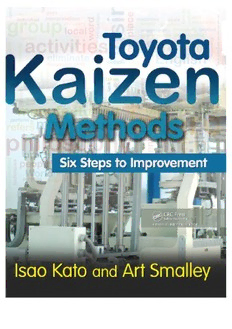
Toyota Kaizen Methods : Six Steps to Improvement. PDF
Preview Toyota Kaizen Methods : Six Steps to Improvement.
Toyota Kaizen Methods Six Steps to Improvement Isao Kato and Art Smalley 2 Productivity Press Taylor & Francis Group 270 Madison Avenue New York, NY 10016 © 2011 by Taylor and Francis Group, LLC Productivity Press is an imprint of Taylor & Francis Group, an Informa business No claim to original U.S. Government works International Standard Book Number: 978-1-4398-8400-3 (epub) This book contains information obtained from authentic and highly regarded sources. Reasonable efforts have been made to publish reliable data and information, but the author and publisher cannot assume responsibility for the validity of all materials or the consequences of their use. The authors and publishers have attempted to trace the copyright holders of all material reproduced in this publication and apologize to copyright holders if permission to publish in this form has not been obtained. If any copyright material has not been acknowledged please write and let us know so we may rectify in any future reprint. Except as permitted under U.S. Copyright Law, no part of this book may be reprinted, reproduced, transmitted, or utilized in any form by any electronic, mechanical, or other means, now known or hereafter invented, including photocopying, microfilming, and recording, or in any information storage or 3 retrieval system, without written permission from the publishers. For permission to photocopy or use material electronically from this work, please access www.copyright.com (http://www.copyright.com/) or contact the Copyright Clearance Center, Inc. (CCC), 222 Rosewood Drive, Danvers, MA 01923, 978-750-8400. CCC is a not-for-profit organization that provides licenses and registration for a variety of users. For organizations that have been granted a photocopy license by the CCC, a separate system of payment has been arranged. Trademark Notice: Product or corporate names may be trademarks or registered trademarks, and are used only for identification and explanation without intent to infringe. Visit the Taylor & Francis Web site at http://www.taylorandfrancis.com and the Productivity Press Web site at http://www.productivitypress.com 4 Contents Foreword 1 Introduction 2 Background of Kaizen in Toyota 2.1 History of Kaizen Methods in Toyota 2.2 The Toyoda Precepts 2.3 Training-Within-Industry Job Methods Introduction 2.4 “P-Course” Introduction 2.5 Development of Toyota’s Kaizen Course 2.6 Operations Management Consulting Division and Jishuken Events at Tier One Suppliers 2.7 Summary Notes 3 Introduction to Kaizen in Toyota 3.1 The Importance of Kaizen 3.2 Key Concepts 5 3.2.1 The Role of a Leader 3.2.2 Five Ways to Increase Production 3.2.3 Processing Methods Affect Cost 3.2.4 Work versus Waste (Muda, Mura, Muri) 3.2.5 Cost Reduction Principle 3.3 Basic Pattern for Kaizen 3.3.1 Step 1: Discover the Improvement Potential 3.3.2 Step 2: Analyze the Current Methods 3.3.3 Step 3: Generate Original Ideas 3.3.4 Step 4: Develop an Implementation Plan 3.3.5 Step 5: Implement the Plan 3.3.6 Step 6: Evaluate the New Method Note 4 Step 1: Discover Improvement Potential 4.1 Introduction 4.2 Kaizen versus Problem Solving 4.3 Kaizen Attitude 6 4.4 Analytic Skills for Kaizen 4.5 Opportunity Awareness 4.6 Basic Methods for Uncovering Waste and Identifying Improvement Opportunities 4.6.1 Compare Performance to Standards 4.6.2 Production Analysis Board 4.6.3 Seven Types of Waste 4.6.4 Five S 4.7 Summary of Step 1: Discover Improvement Potential 4.7 Homework Assignment Note 5 Step 2: Analyze Current Methods 5.1 Introduction 5.2 Basic Analysis Methods 5.2.1 Work Analysis 5.2.1.1 Work Analysis Units 5.2.1.2 Training-Within-Industry Job Methods Analysis 5.2.1.3 Toyota Work Analysis 7 5.2.2 Motion Analysis 5.2.3 Time Study 5.2.4 Standardized Work 5.2.5 Machine Loss Analysis 5.2.5.1 Equipment Breakdowns 5.2.5.2 Equipment Changeover 5.2.5.3 Equipment Cycle Time 5.2.5.4 Minor Stops 5.2.5.5 Scrap or Rework 5.2.5.6 Startup or Yield Losses 5.2.6 Material Flow Analysis 5.3 Summary 5.4 Homework Assignment Notes 6 Step 3: Generate Original Ideas 6.1 Introduction 6.2 Key Concepts Regarding Idea Generation 8 6.2.1 Common Roadblocks to Creativity 6.2.1.1 Force of Habit 6.2.1.2 Preconceptions 6.2.1.3 Common Sense 6.2.1.4 Not Invented Here Syndrome 6.2.1.5 Emotion 6.2.2 General Advice Regarding Creativity and Teams 6.2.2.1 Separate Idea Generation from Judgment 6.2.2.2 Generate as Many Ideas as Possible 6.2.2.3 Think from Different Angles 6.2.2.4 Combine Ideas with Others 6.2.2.5 Review Previous Analysis 6.2.2.6 Synthesis Ideas 6.2.3 Methods for Developing Ideas 6.2.3.1 Osborn’s Checklist 6.2.3.2 Rules for Motion Economy 6.2.3.3 Further Suggestions for Manual Work 9 6.2.3.4 Review 5W 1H and ECRS 6.2.3.5 Brainstorming 6.3 Summary 6.4 Homework Assignment Notes 7 Step 4: Develop an Implementation Plan 7.1 Introduction 7.2 Key Concepts 7.2.1 Six Points for Consideration in Planning 7.2.2 Implementation Cases and Planning 7.3 Summary 7.4 Homework Exercise 8 Step 5: Implement the Plan 8.1 Introduction 8.2 Key Concepts 8.3 Summary 8.4 Homework Exercise 10
